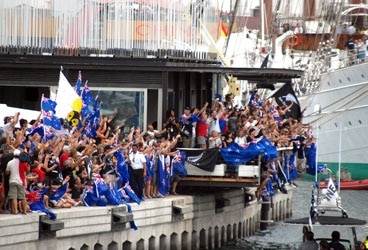
AC07_0626_Main
VALENCIA, Spain-Countless times during the course of the Louis Vuitton Cup, Emirates Team New Zealand tactician Terry Hutchinson mentioned how the team loves a good fight, how the Kiwi crew is more comfortably leading a race by 2 boatlengths than 20. It often seemed more mantra than reality.However after the third race of the America’s Cup, no one will question that statement again. Team New Zealand, after nailing the first shift and building a 350-meter lead midway down the first beat. The race looked like a laugher-something Alinghi has never really experienced. But after then some defensive sailing by Team New Zealand on the run, a couple of rare crew mistakes, Alinghi charged back into the race and eventually into the lead. On the second beat, the Swiss team made up an astounding 1:17, going from 1:02 behind to 15 seconds ahead. It was only with the pressure back on, and trailing by 100 meters, that Hutchinson and his team found their stride again.The final run was one for the ages. Two thirds of the way down it, the two teams crossed paths with Alinghi choosing to continue on starboard, allowing Team New Zealand to take the right side of the course. It was the decision that decided the race. With the separation maxing out at 1200 meters, Team New Zealand picked up a favorable shift on the right side of the course-a left shift as opposed to a right shift often expected in Valencia-and gradually ate into the lead, eventually taking control of the advantage line. Alinghi’s Rodney Ardern explains why the team, with the lead, allowed Team New Zealand to get so much separation.It was tense from there to the finish; the wind so light that it was all the trimmers could do to keep the spinnaker full. But Team New Zealand was able to hold the lead through the finish, nailing its final jibe and crossing the finish line 25 seconds ahead to take a 2-1 lead in the 32nd America’s Cup. It was a clutch performance by a team that seemed completely unglued two legs earlier as it botched a spinnaker douse and struggled to get back up to speed. Mastman Matt Mason explains how the douse went so pear-shaped so quickly. It was without a doubt one of the best races in recent America’s Cup history, though you wouldn’t have known it from the comments from Alinghi, who to a man felt the race should not have been run in the very shifty conditions. Listen to runner/pitman Dean Phipps put his spin on it.This race seemed like it was little more than a formality 10 minutes after the start. In fact, the crucial decision seemed to have been made before the start as Team New Zealand fought hard for the right, giving up nearly eight seconds off the line-and nearly two boatlengths of distance once the boats settled onto their respective tacks, starboard for Alinghi and port for Team New Zealand. Phipps says Alinghi got the start it wanted, but not the result. This decision paid off quickly as Team New Zealand nailed the first shift, a huge righthander. From there the breeze seemed to favored the right all the way up the bat and Emirates Team New Zealand built a lead that would stretch to more than 200 meters. ETNZ’s wind spotter Adam Beashel explains how the team got the start right in this audio clip.The delta around the first mark was 1:23, the advantage line more than 350 meters. Alinghi jibed first, with Team New Zealand following a minute or so later. In those conditions covering from ahead is very difficult. The apparent wind on the boats goes so far forward that the boat ahead is usually forced to wait a significant amount of time before jibing to follow the boat behind. Because of this, the minimum separation on a run like that can be 300 meters. ETNZ weather strategist Ray Davies explains why covering downwind in lilght air is so difficult for the lead boat.The lead on the run varied between 200 meters and 350 meters depending on which team had the pressure. Toward the bottom of the run, Team New Zealand jibed into a position where it could cover Alinghi’s move toward the right side of the course and still leave itself with one jibe for the left-side gate mark. However a right shift pushed Team New Zealand down toward, but not quite to, the layline, and drastically favored the right-side gate mark. The result was the team’s worst takedown of this America’s Cup cycle. Midbowman Richard Meacham fell overboard, saving himself by grasping the bob stay, and the spinnaker came down very slowly. Worse yet, the spinnaker fouled in the genoa trimming system and the team struggled to get up to speed.While Team New Zealand had rounded with a wind direction of 135 degrees, a huge right shift, Alinghi came in a minute later and rounded with the wind 20 degrees or so to the left. The Swiss team lifted off the Kiwi’s line and then tacked to play the left side. By the time the boats came together halfway up the beat, they were bow even. Team New Zealand was able to plant a leebow on SUI-100, though it took a minute or so to stick. Team New Zealand followed suit a minute or so later and initially appeared to be benefiting from a right shift. When the shift went the other way Alinghi tacked and forced TNZ back toward the starboard-tack layline. When the two boats came together on the port-tack layline; Alinghi was able to cross clean ahead and round with a 15-second lead.Tomorrow’s race looks quite crucial for Alinghi and the conditions look like they could be quite similar. But Ardern doesn’t expect anything to change in the team’s approach.









